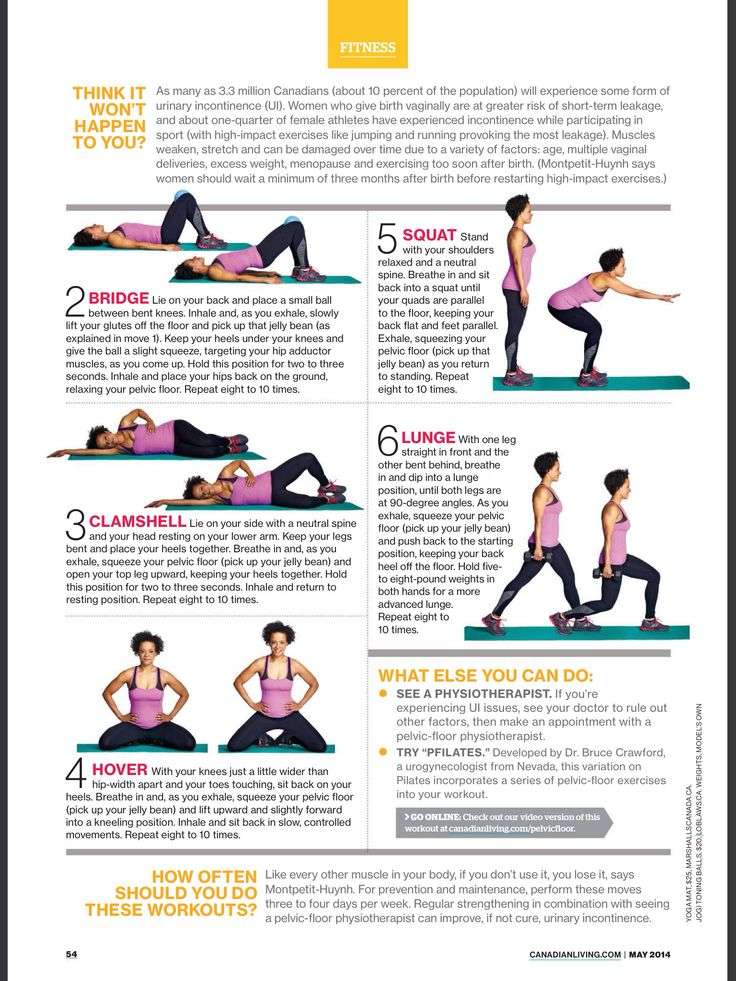Strengthen Your Pelvic Floor Muscles To Improve Urinary Continence
Tackling urinary continence is all about working the pelvic muscles. So why do these muscles matter? The pelvic floor muscles extend from the inside of your pubic bone all the way to your anus and are woven around your urethra, vagina, and rectum. They control the contractions of your bladder muscle as well as the pressure in the urethra. These actions combine to start and stop the flow of a stream of urine. When you contract these muscles, the lower urethra closes and squeezes any urine back up your bladder, preventing leakage. When they relax the urine flows out. If these muscles arent strong, the tightening may not be effective, causing urine to leak. As you exercise these muscles and make them stronger, you should notice less frequent accidents and should be able to go longer without using the bathroom. Doing more repetitions and holding your contractions for longer are other ways to make this more effective.4
The Squeeze & Release
The squeeze and release is your secret weapon towards getting your pelvic muscles to respond quickly. This can be very helpful for stopping leaks in pinch!To squeeze and release:
- Sit or stand in a comfortable position and think of the muscles used to control your urine flow.
- Squeeze your pelvic muscles as quickly as possible and rapidly release them with no attempt to hold the position.
- Take a rest for 5 to 10 seconds.
- Repeat contracting your pelvic muscles for 10 to 20 reps.
- Perform this exercise 3 times throughout the day.
To Learn Which Muscles To Exercise:
- While you are urinating, try to stop or slow the urine without tensing the muscles of your legs, buttocks, or abdomen. It is very important not to use these other muscles, because only the pelvic floor muscles help with bladder control.
- When you are able to slow or stop the stream of urine, you have located the correct muscles. Feel the sensation of the muscles pulling inward and upward.
Helpful Tip: Squeeze in the rectal area to tighten the anus as if trying not to pass gas. Once you have found the right muscles, do NOT interrupt your urine flow.
Now you are ready to exercise regularly:
- When you have located the correct muscles, set aside three to four times each day to exercising: morning, midday, and evening.
- Squeeze your muscles to the slow count of four. Then, relax these muscles completely to the slow count of four. .
- Complete 10 sets during each of your daily exercise sessions.
Make pelvic floor exercises a part of your routine:
- Whether you are doing pelvic muscle exercises to improve or maintain bladder control, you must do them regularly on a lifetime basis.
- Use the daily routines such as watching TV, reading, stopping at traffic lights, and waiting in the grocery checkout line as cues to perform a few exercises.
Don’t Miss: Does Ibuprofen Irritate The Bladder
Pelvic Floor Exercises And Stress Incontinence
Reviewed byDr Hannah Gronow
Pelvic floor exercises, also known as Kegel exercises, have numerous benefits and may help cure stress incontinence. Pelvic floor exercises are also useful to prevent incontinence for women who have had children. In addition, some people feel that having strong pelvic floor muscles heightens the pleasure when having sex.
How Do I Do Kegel Exercises

Kegel exercises are a simple way to build strength in your pelvic floor muscles. These exercises are done by lifting, holding and then relaxing your pelvic floor muscles. You can find these muscles by stopping the flow of urine mid-stream while youre urinating. Only do this until you learn how to find the muscles stopping the flow of urine mid-stream isnt healthy over a long period of time.
When youre doing Kegel exercises, start small. Only hold it for a few second. Over time you can slowly work your way up to longer and longer stretches of holding the muscles tight.
Unlike other types of workouts, no one can tell when youre doing Kegel exercises. Aim to do several sets of Kegel exercises twice a day.
Recommended Reading: Does Bladder Cancer Pain Come And Go
Avoid High Impact Exercise: It Can Make Leakage Worse
If youre looking at losing weight or exercising to help your urinary incontinence, be aware that high impact exercise can actually make things worse by putting pressure on the pelvic floor muscles. Even sit-ups may prove problematic. So skip the aerobics classes and trade in your running shoes for some yoga or pilates. This will help you build core strength, stretch your body, and get a good workout without taking a toll on your pelvic floor muscles. Plus, as we saw, yoga has some asanas that are actually beneficial for the pelvic region.16
References
Kegels A Womans Most Essential Exercise
Kegel exercise is the #1 doctor-recommended treatment for solving and preventing bladder leaks. Just like your other muscles, your pelvic floor needs exercise too! From ensuring a healthy pregnancy and childbirth to maintaining control over the bladder, the pelvic floor is one of a womans most important muscle groups.
As with any exercise, its important to use the right technique if you have questions or are worried that youre doing it incorrectly your doctor can help you perfect your form. A good set of weighted Kegel exercisers can also help make your routine more effective just like a set of dumbbells helps you build strength in your arms.
So while toning up your thighs and derriere might make you look and feel good, integrating Kegel exercises into your daily routine will help your pelvic floor stay strong and effective throughout your lifetime.
Don’t Miss: Loss Of Bladder Control When Coughing
Strengthening Your Pelvic Floor Muscles
Millions who suffer with urinary incontinence feel like their bladder controls their lives. Control depends on muscles working together. This simple step can control your bladder!
National Institute of Diabetes and Digestive and Kidney Diseases, National Institutes of Health
When the bladder fills, the bladder muscles should be relaxed and the muscles around the urethra , called the pelvic floor muscles, should be tight. Exercises that strengthen these muscles can help prevent leakage and calm the urge to go. These are commonly called “Kegel” exercises, named after the doctor who developed them. They can help keep your pelvic floor muscles toned and may reduce your problems with leakage or frequent urges to urinate.
Do Pelvic Floor Exercises Make A Difference
It takes time, effort and practice to become good at pelvic floor exercises/Kegels. It is best do these exercises for at least three months to start with. You should start to see benefits after a few weeks. However, it often takes two to five months for most improvement to occur. After this time you may be cured of stress incontinence. If you are not sure that you are doing the correct exercises, ask a doctor, physiotherapist or continence advisor for advice.
If possible, continue exercising as a part of everyday life for the rest of your life. Once incontinence has gone, you may only need to do one or two bouts of exercise each day to keep the pelvic floor muscles strong and toned up and to prevent incontinence from coming back.
Recommended Reading: Antibiotics Given For Bladder Infection
Exercise And Stress Urinary Incontinence
Stress urinary incontinence, the type of incontinence that most often causes leaks during exercise, is characterized by involuntary leakage of urine because of activity like coughing, jumping, or lifting that increases pressure in your abdomen.
Exercise, particularly high impact sports like basketball and running, also has this effect, which can put pressure on your bladder and urethra. Your pelvic floor responsible for supporting your pelvic organs should usually help keep your bladder sphincter closed.
However, if its weak or damaged, your pelvic floor doesnt function as well and some urine might leak out. However, there are steps you can take to prevent leaks not just manage the symptoms with pads and dark clothing:
How To Find The Right Muscles
A Kegel exercise is like pretending you have to urinate and then holding it. You relax and tighten the muscles that control urine flow. It is important to find the right muscles to tighten.
Next time you have to urinate, start to go and then stop. Feel the muscles in your vagina , bladder, or anus get tight and move up. These are the pelvic floor muscles. If you feel them tighten, you have done the exercise right. Your thighs, buttock muscles, and abdomen should remain relaxed.
If you still are not sure you are tightening the right muscles:
- Imagine that you are trying to keep yourself from passing gas.
- Women: Insert a finger into your vagina. Tighten the muscles as if you are holding in your urine, then let go. You should feel the muscles tighten and move up and down.
- Men: Insert a finger into your rectum. Tighten the muscles as if you are holding in your urine, then let go. You should feel the muscles tighten and move up and down.
Also Check: Difference Uti And Bladder Infection
How Long Should You Continue With These Exercises
Like any group of muscles, it is in your own interest to keep them in good shape so really everyone should be exercising their pelvic floor muscles from childhood through to old age.
If you already have some symptoms that might be caused by a weakened pelvic floor, do not be disappointed if you do not notice any improvement even after a month or two of exercising it is a long process, which needs patience and some willpower. It may help to talk to a specialist continence adviser or a continence physiotherapist about the exercises to make sure you are doing them properly. They may also be able to suggest additional exercises, exercise devices or muscle stimulation which could speed up the process.
Pelvic Floor Exercises To Help Strengthen The Bladder And Prevent Incontinence

It may not be something people feel comfortable talking about but bladder incontinence is an issue that impacts many people in the older community. It affects around 37 per cent of women in the general population and 13 per cent of men and one way many people can strengthen their bladder is through pelvic floor exercises.
When women become menopausal, there are several hormonal shifts which can affect the bladder, while the growth of the prostate can cause problems in men. Other people can develop bladder weakness through heavy lifting, a history of pregnancy or vaginal birth, pelvic surgeries, hysterectomies or operations on the prostate.
According to the Continence Foundation Australia, a healthy bladder is one that empties between four and six times a day, can hold between 400ml and 600ml of urine, wakes you up no more than twice a night if youre over 65, doesnt leak urine and empties completely when a person goes to the bathroom. If this doesnt sound like your bathroom habits, practicing pelvic floor exercises may assist.
Recommended Reading: What Causes Bladder Control Problems
Pelvic Floor Exercises For Women
Women can strengthen the pelvic floor muscles by imagining theyre holding the flow of urine, holding in wind and trying to squeeze, pull up and hold the muscles in that area. Those who experience leakage with coughing or sneezing should typically start seeing improvements after six weeks of pelvic floor exercises.
Having said that, it can take longer to notice significant strength changes and this can take anywhere from three months to 12 months.
When practicing pelvic floor exercises, there should be no form of baring down or straining, because this can cause further problems. Instead, people should focus on pulling the muscles skywards. Exercises should also be completed three times a day and consistency is the key.
Reclining Bound Angle Posev
Also referred to as Supta Baddha Konasana, it is a classic restorative Yoga pose that can work the entire pelvic floor muscles.
Read Also: Botox Injections For Bladder Control
Malasana Or Garland Pose
Research has found that yoga can be beneficial for those with urinary incontinence.11 The simple squat pose or malasana can help strengthen your pelvic floor and allow you to contract it more forcefully.12
- Squat on the ground bringing your feet as close together as you can manage.
- Move your thighs a little further apart so they are wider than your torso.
- Breathe out as you lean your torso forward. It should fit between your thighs snugly.
- Press into your inner knees with the elbows and bring your palms to each other in salutation. Lengthen your front torso.
- Next, if you want to deepen the pose, try and press your inner thighs to the sides of the torso. Simultaneously, reach your arms ahead, swinging them to either side and fit your shins into your armpits. Let your fingertips press into the ground or clasp the back of your heels with them from the outside of your ankles.
- Hold this position for 30 seconds and work up to a minute over time.
- Breathe in as you straighten your knees and stand.
Pelvic Floor Exercises For Men
Pelvic floor exercises differ slightly in men and are a bit easier because they have a visual tool to assist them. For example, if a man stands in front of a mirror, he can imagine that hes trying to stop the flow of urine or holding onto wind.
When men do this, they will see their scrotum lift and the penis retract. Noticing these visual cues lets men know theyre doing the exercises correctly.
Its advised to start off with a shorter squeeze for around three seconds and then resting for a similar length of time. Both men and women should aim for 10 repetitions of the exercises to see improvements.
Don’t Miss: What Causes An Overactive Bladder At Night
When Should I See A Doctor About Incontinence
Its important to know that incontinence can be treated. Many people believe that its something that just goes along with aging and is an unavoidable issue. If you find that incontinence is disturbing your daily activities and causing you to miss out on things you typically enjoy, talk to your healthcare provider. There are a wide range of options to treat incontinence.
What Are The Pelvic Floor Muscles
The pelvic floor muscles are a group of muscles that wrap around the underneath of the bladder and rectum. Your doctor may advise that you strengthen your pelvic floor muscles:
- If you develop stress incontinence. In stress incontinence, urine leaks when there is a sudden extra pressure on the bladder. Urine tends to leak most when you cough, laugh, or exercise . Strengthening the pelvic floor muscles can often cure stress incontinence.
- After childbirth. The common reason for the pelvic floor muscles to become weakened is childbirth. If you do pelvic floor muscle exercises after childbirth, it may prevent stress incontinence developing later in life.
You May Like: Bladder Leakage Without Feeling It
Reclining Bound Angle Pose
- Remain on the floor, but remove your yoga block, while keeping your knees bent.
- Inhale and slowly spread your knees, dropping them to the floor on the sides.
- Exhale while slowly bringing your knees together and lifting your pelvis off the floor.
- Contract your pelvic muscles.
- Release them and return to the floor.
Can Physical Therapists Help With Kegels

Absolutely. Pelvic floor physical therapists can teach you how to do kegels in a correct and more effective way. They use different techniques for monitoring and provide feedback. Its like having a personal trainer at the gym. You can find instructions for kegels online and do them on your own, but if you have someone who teaches you how to do them, and gives you professional feedback, it helps you do the exercises correctly and more effectively. Its been proven in research studies that its more effective than doing them on your own. At the University of Chicago Medicine, we have a very good physical therapy team that specializes in pelvic floor issues.
Read Also: Where Is Your Bladder Woman
What Can Happen If You Do A Kegel Incorrectly
Women often incorrectly contract their buttocks or gluteal muscles, or inner thighs, and basically squeeze their thighs together. Many strain and increase their abdominal pressure. Thats not good for two reasons. One, its ineffective. And two, straining results in the opposite effect. Chronic straining is a risk factor for developing and worsening problems like pelvic organ prolapse or stress incontinence.
How To Stop Bladder Leakage
Bladder control issues refer to the unwilling release of urine. While poor bladder control doesnt cause any major health issues, it can lead to some pretty embarrassing moments. Leakage can occur due to an overactive bladder or urinary incontinence.
The good news is that this condition is almost always treatable, and is most definitely not a necessary consequence of aging, childbirth, or an unavoidable part of being a woman.
Read Also: Is Green Tea Good For Bladder Infection